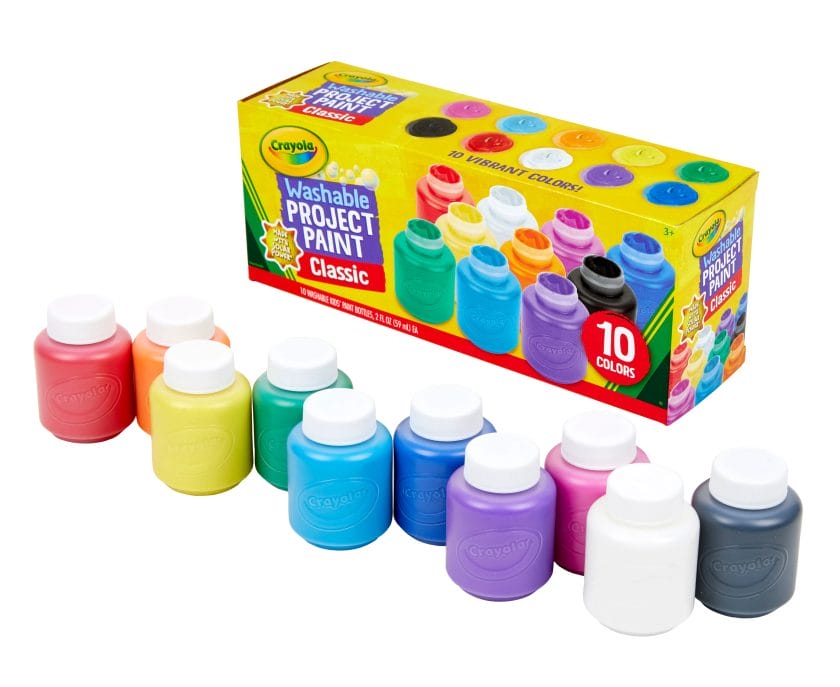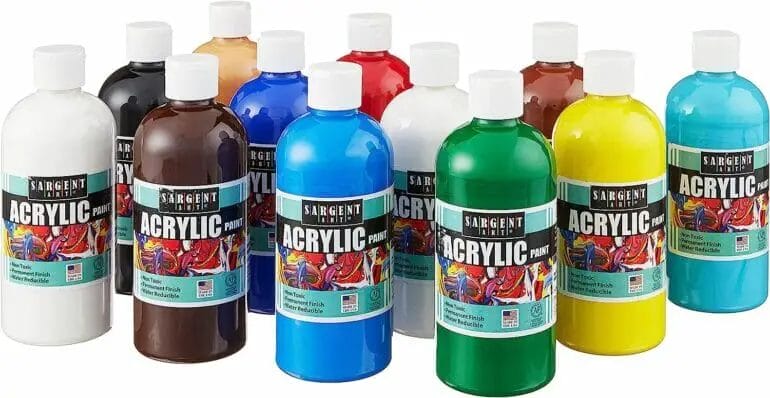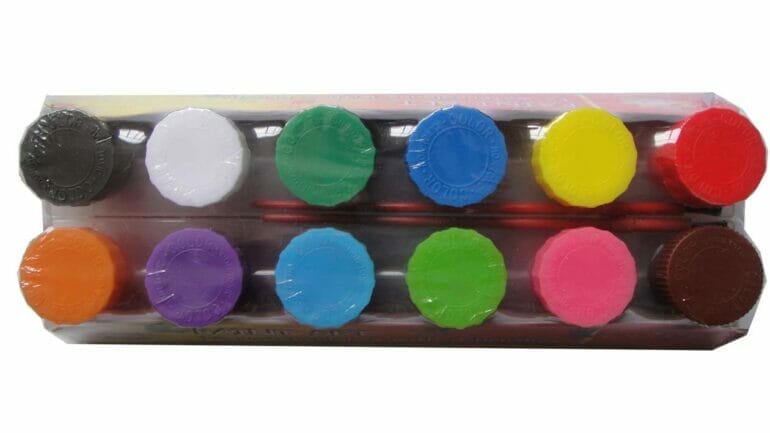Acrylic paint is a popular choice among artists due to its vibrant colors and versatility. One of the key concerns artists often have is whether acrylic paint is non-toxic. Fortunately, most acrylic paints on the market today are non-toxic, making them safe for use by both adults and children. Non-toxic acrylic paints are free from harmful chemicals and have low VOC (volatile organic compounds) levels, ensuring minimal risks to your health and the environment. It’s always essential to check the label or product description to confirm if the acrylic paint you’re using is non-toxic.

Understanding Non-Toxic Acrylic Paint: Benefits and Precautions
Acrylic paint is a popular choice among artists, hobbyists, and DIY enthusiasts due to its versatility and vibrant colors. However, traditional acrylic paints often contain toxic chemicals that can be harmful to both the environment and our health. This is where non-toxic acrylic paint comes in, offering a safer alternative without compromising on quality.
Benefits of Non-Toxic Acrylic Paint
Non-toxic acrylic paint is formulated without the use of harmful chemicals, such as volatile organic compounds (VOCs) and heavy metals. Here are some benefits of using non-toxic acrylic paint:
- Safe for Health: Traditional acrylic paints emit toxic fumes that can cause respiratory issues, skin irritation, and other health problems. Non-toxic acrylic paint eliminates these risks, making it safe for artists of all ages, including children.
- Environmentally Friendly: The production and disposal of traditional acrylic paint contribute to air and water pollution. On the other hand, non-toxic acrylic paint is water-based and contains biodegradable ingredients, making it more eco-friendly.
- Wide Color Selection: Non-toxic acrylic paint offers a wide range of colors and finishes, allowing artists to explore their creativity without limitations. Whether you prefer bright and bold hues or subtle pastels, there is a non-toxic acrylic paint for every artistic vision.
- Durable and Versatile: Non-toxic acrylic paint provides excellent adhesion, durability, and versatility. It can be used on various surfaces, including canvas, wood, paper, and more. The paint dries quickly, allowing for easy layering and blending.
- Easy Cleanup: Unlike traditional oil-based paints, non-toxic acrylic paint can be easily cleaned up with soap and water. Brushes, palettes, and other tools can be rinsed without the need for harsh solvents or chemicals, making the painting process more convenient.
Precautions to Take While Using Non-Toxic Acrylic Paint
Although non-toxic acrylic paint is generally safer to use, it is still important to take certain precautions to ensure your safety and maximize the longevity of your artwork:
- Ventilation: It is recommended to work in a well-ventilated area or use a ventilation system when working with any type of paint, including non-toxic acrylic paint. Proper airflow helps to reduce the concentration of paint fumes.
- Protective Gear: While non-toxic acrylic paint is less harmful, it is still advisable to wear protective gear, such as gloves and a mask, to prevent direct contact with the paint and inhalation of any airborne particles.
- Proper Storage: Store non-toxic acrylic paint containers tightly closed in a cool, dry place to prevent them from drying out or becoming contaminated. This will ensure the longevity and quality of the paint.
- Dispose of Waste Responsibly: When disposing of unused paint or paint-related materials, follow the proper guidelines for your local area. Some communities may have specific regulations for the disposal of paint waste.
- Keep Out of Reach of Children: While non-toxic acrylic paint is considered safe for children, it is always best to supervise their use and ensure they are using it responsibly, especially at a young age.
In summary, non-toxic acrylic paint offers numerous benefits over traditional acrylic paint, such as being safer for health, more eco-friendly, and easy to clean up. By following some simple precautions, artists can enjoy the versatility and vibrant colors of non-toxic acrylic paint while minimizing any potential risks.

Choosing the Best Non-Toxic Acrylic Paint for Art Projects
Acrylic paints are a popular medium for artists due to their versatility and vibrant colors. However, many acrylic paints contain toxic ingredients that can be harmful to your health and the environment. If you are concerned about using toxic chemicals in your art projects, it is important to choose non-toxic acrylic paints. In this section, we will discuss how to select the best non-toxic acrylic paint for your art projects.
1. Look for Safety Certifications
When purchasing acrylic paint, check if the product has any safety certifications. Look for paints that are certified non-toxic, meaning they do not contain harmful chemicals. These certifications are typically displayed on the packaging, and reputable brands will prioritize safety and environmental standards.
2. Check the Label for Ingredient Information
Read the ingredient list on the paint label to identify any potentially toxic substances. Avoid paints that contain heavy metals such as cadmium, lead, or chromium. These metals can be harmful if ingested, inhaled, or absorbed through the skin. Opt for paints that are labeled as “heavy metal-free” or “low VOC” (volatile organic compounds).
3. Consider Water-Based Acrylic Paints
Water-based acrylic paints are generally safer and more environmentally friendly than oil-based or solvent-based paints. They have lower levels of toxic chemicals and emit fewer harmful fumes. Water-based acrylic paints also have the advantage of being easy to clean up with water, making them ideal for artists working in shared spaces or with limited ventilation.
4. Research the Brand’s Reputation
Do some research on the brand of acrylic paint you are considering. Look for reviews and testimonials from other artists who have used the paint. Reputable brands often prioritize the quality and safety of their products. Look for brands that have a good reputation for producing non-toxic acrylic paints.
5. Consider Price and Quality
Price and quality are important factors to consider when choosing acrylic paint. While non-toxic paints may be slightly more expensive, they are worth the investment for the health and safety benefits. Look for paints that offer good coverage, vibrant pigments, and durability. It is also helpful to read reviews or ask for recommendations from fellow artists.
6. Test the Paint Before Committing
If possible, test the paint before committing to a large purchase. This can be done by purchasing a small sample or using a friend’s paint. Testing the paint will allow you to assess its consistency, color vibrancy, and ease of use. It will also give you an opportunity to check if you have any adverse reactions to the paint.
7. Explore Natural and Organic Options
For artists who want to take their non-toxic commitment further, there are natural and organic acrylic paint options available. These paints are made from natural pigments and binders, and they often have a lower environmental impact. While they may be more expensive, they offer a sustainable and eco-friendly alternative.
In summary, choosing the best non-toxic acrylic paint for your art projects involves considering safety certifications, checking the ingredient list, opting for water-based paints, researching the brand’s reputation, considering price and quality, testing the paint, and exploring natural and organic options. By selecting non-toxic paints, you can prioritize your health and contribute to a safer and more sustainable artistic practice.

Exploring the Health Risks and Environmental Impact of Acrylic Paints
Acrylic paints have gained popularity in the art world due to their versatility, vibrant colors, and fast drying time. However, it is important to understand the potential health risks associated with using these paints and the impact they have on the environment. In this section, we will delve into the various aspects of acrylic paints that can pose risks and explore sustainable alternatives.
1. Chemical Composition of Acrylic Paints
Acrylic paints are made up of pigments suspended in a polymer emulsion, typically composed of acrylic polymers. These paints often contain volatile organic compounds (VOCs), which are chemicals that can vaporize at room temperature and have the potential to cause health issues.
Common VOCs found in acrylic paints include formaldehyde, toluene, ethylbenzene, and xylene. Prolonged exposure to these chemicals can lead to respiratory problems, allergic reactions, headaches, and even more severe health issues.
2. Health Risks for Artists
Artists who frequently use acrylic paints may be at risk of developing health problems due to the inhalation of VOCs or dermal contact with the paints. The fumes emitted by acrylic paints can irritate the eyes, nose, and throat, and prolonged exposure may result in chronic respiratory conditions.
Direct contact with the skin can cause skin irritation, dermatitis, or even chemical burns. Some artists may also develop allergies or sensitivities to certain pigments or additives present in acrylic paints.
3. Environmental Impact
Acrylic paints have both direct and indirect environmental impacts. The production process of acrylic paints involves the release of harmful chemicals and waste products into the environment. Additionally, improper disposal of acrylic paints can contaminate water sources and harm aquatic life.
When acrylic paints dry, they form a non-biodegradable plastic film. If this film ends up in landfills, it contributes to the accumulation of plastic waste, which has serious consequences for the environment.
4. Sustainable Alternatives
Fortunately, there are sustainable alternatives available for artists who want to minimize the health risks and environmental impact associated with acrylic paints. Some options include:
- Water-based paints: Watercolor paints and gouache are water-based alternatives that do not contain harmful solvents or VOCs. They are also easier to clean up as they can be washed off with water.
- Natural pigments: Artists can opt for natural pigments derived from plants, minerals, or even insects. These pigments are often less toxic and have a lower environmental impact.
- Recycled paints: Some companies produce recycled paints using leftover or discarded paint. These paints help reduce waste and minimize the need for new production.
In summary, while acrylic paints offer many benefits for artists, it is crucial to be aware of the potential health risks and environmental impact associated with their use. By exploring sustainable alternatives and adopting proper safety measures, artists can continue to create while minimizing harm to themselves and the environment.
Tips for Safely Using and Storing Non-Toxic Acrylic Paints
Non-toxic acrylic paints are a popular choice among artists of all levels due to their vibrant colors, versatility, and ease of use. However, it is still important to handle and store these paints with care to ensure your safety and the longevity of your materials. In this section, we will discuss some valuable tips for safely using and storing non-toxic acrylic paints.1. Read and Follow the Instructions
Before using any art supplies, including non-toxic acrylic paints, it is crucial to read and follow the instructions provided by the manufacturer. This will give you important information regarding proper usage, potential hazards, and safety precautions. Take the time to familiarize yourself with the product to ensure you are using it correctly.2. Work in a Well-Ventilated Area
Non-toxic acrylic paints are generally safe to use, but they can still release fumes that may cause respiratory irritation if used in a poorly ventilated space. Make sure to work in a well-ventilated area, such as a room with windows or a studio equipped with ventilation systems. This will help to minimize exposure to any potentially harmful substances.3. Wear Protective Gear
While non-toxic acrylic paints are considered safe for use, it is always recommended to wear protective gear, especially if you have sensitive skin or are prone to allergies. Consider wearing gloves, an apron, and safety glasses to protect your skin, clothing, and eyes from accidental spills or splashes.4. Avoid Ingestion and Contact with Eyes
Although non-toxic acrylic paints are not harmful if ingested in small amounts, it is still important to avoid ingestion as much as possible. Keep your paints away from food and beverages, and make sure to wash your hands thoroughly after each painting session. Additionally, avoid direct contact with your eyes and rinse them immediately with water if any paint comes into contact with them.5. Store Properly
Proper storage of non-toxic acrylic paints is crucial for maintaining their quality and longevity. Store your paints in a cool, dry place away from direct sunlight, extreme temperatures, and humidity. Make sure the lids are tightly sealed to prevent evaporation and to keep the paint from drying out.6. Dispose of Waste Responsibly
When it comes to disposing of any paint waste, including non-toxic acrylic paints, it is essential to do so responsibly. Avoid pouring leftover paint or rinsing paintbrushes down the sink or drain, as this can contaminate water sources. Instead, allow leftover paint to dry before disposing of it in your regular household trash. Consider donating unused paint to local art centers or organizations in need. In summary, by following these tips, you can safely use and store non-toxic acrylic paints. Remember to read and follow the manufacturer’s instructions, work in a well-ventilated area, wear protective gear, avoid ingestion and contact with eyes, store the paints properly, and dispose of waste responsibly. By taking these precautions, you can enjoy your artistic endeavors while prioritizing your safety and the environment.FAQs
Is acrylic paint non-toxic?
Yes, acrylic paint is generally non-toxic. However, some pigments or additives used in certain acrylic paints may be toxic, so it’s important to read the label or check the manufacturer’s safety information. It’s always a good idea to use proper ventilation and avoid ingesting or inhaling the paint.
How long does acrylic paint take to dry?
The drying time of acrylic paint depends on various factors such as humidity, thickness of the paint layer, and the brand of paint used. Generally, acrylic paint dries to the touch within 20-30 minutes, but it may take several hours or even days to fully cure and become more durable.
Can I mix different brands of acrylic paint?
Yes, you can mix different brands of acrylic paint together. Acrylic paint is water-based and compatible with other acrylic paints, regardless of the brand. However, keep in mind that different brands may have slightly different color shades or consistencies, so it’s recommended to test the mixture on a small surface before using it for a larger project.
Conclusion
In conclusion, acrylic paint is a highly versatile and widely used medium that offers numerous benefits. It is known for its vibrant colors, quick drying time, and long-lasting durability. One of the major advantages of acrylic paint is its non-toxic nature, making it safe for artists of all ages and abilities to use. Whether you are a professional artist or a beginner, acrylic paint provides a wide range of options for creativity and expression, without posing any health risks. So, next time you pick up a paintbrush, rest assured that you can enjoy the benefits of acrylic paint while keeping your health and safety a top priority.
